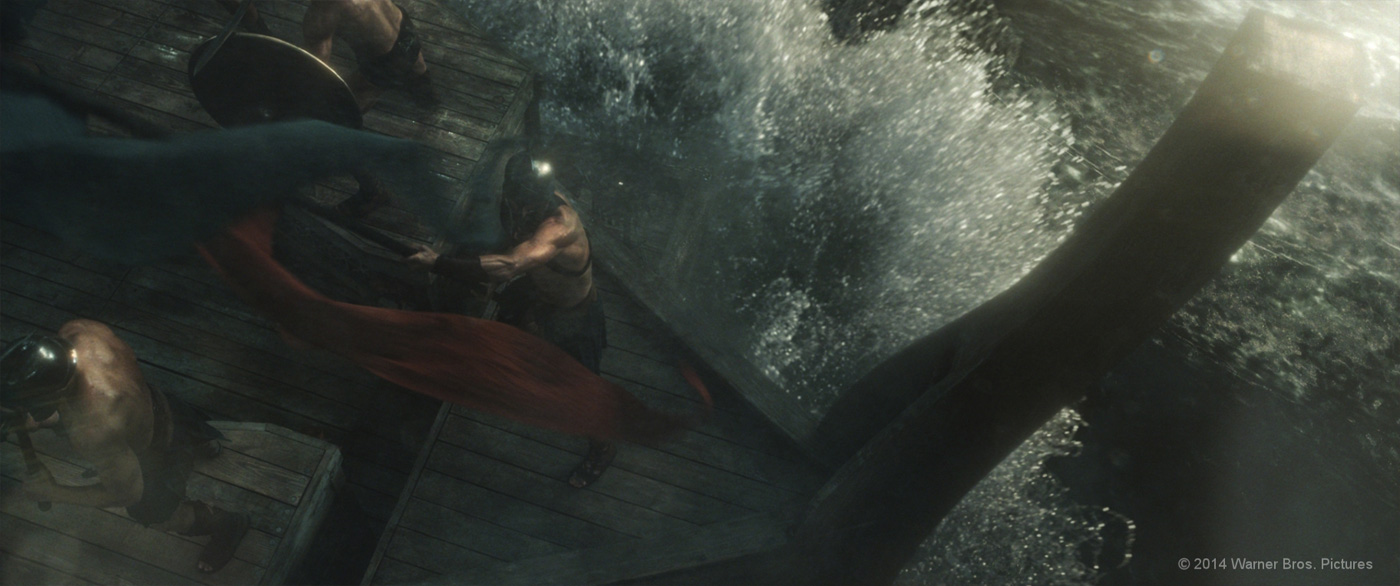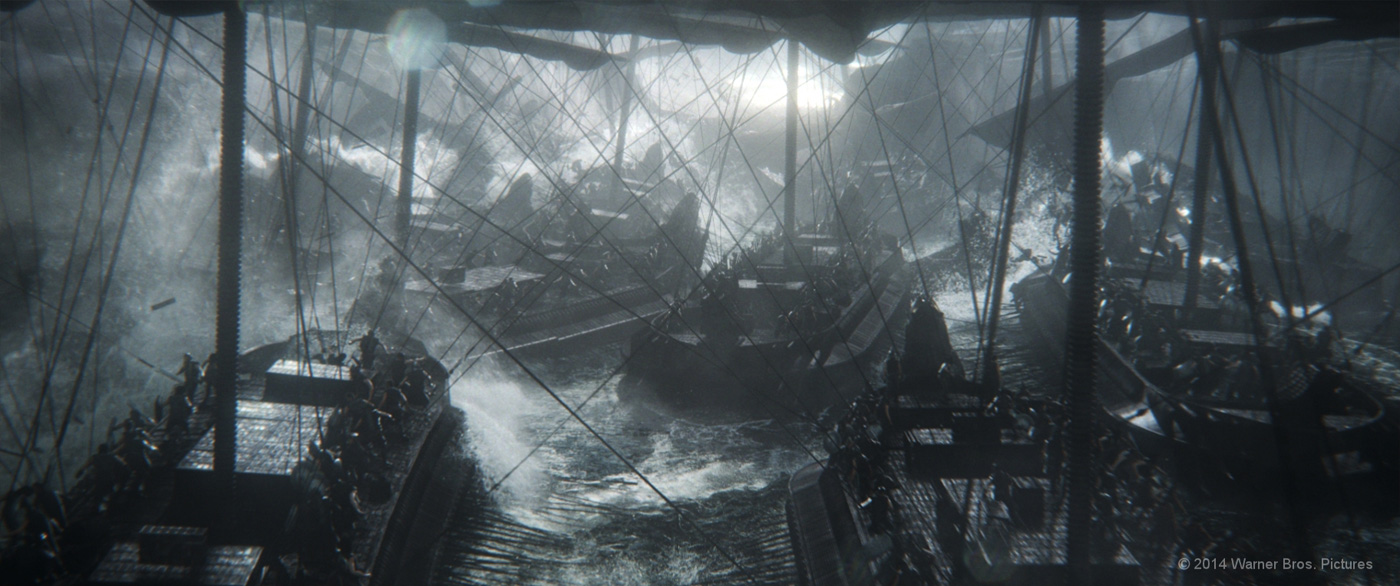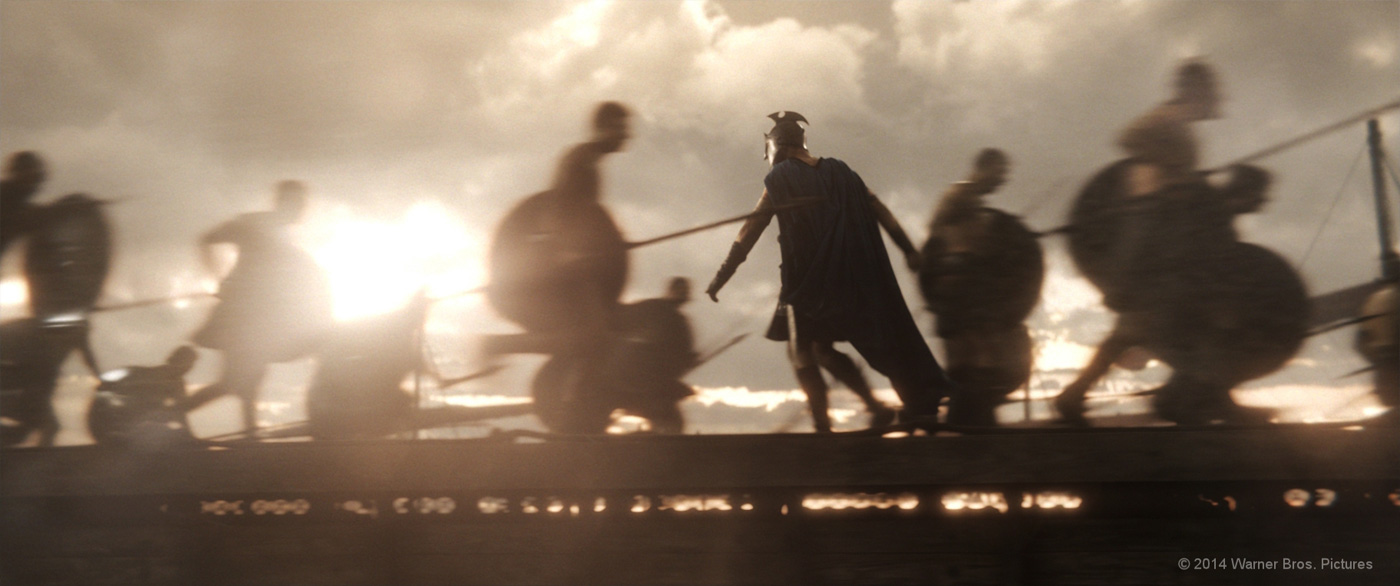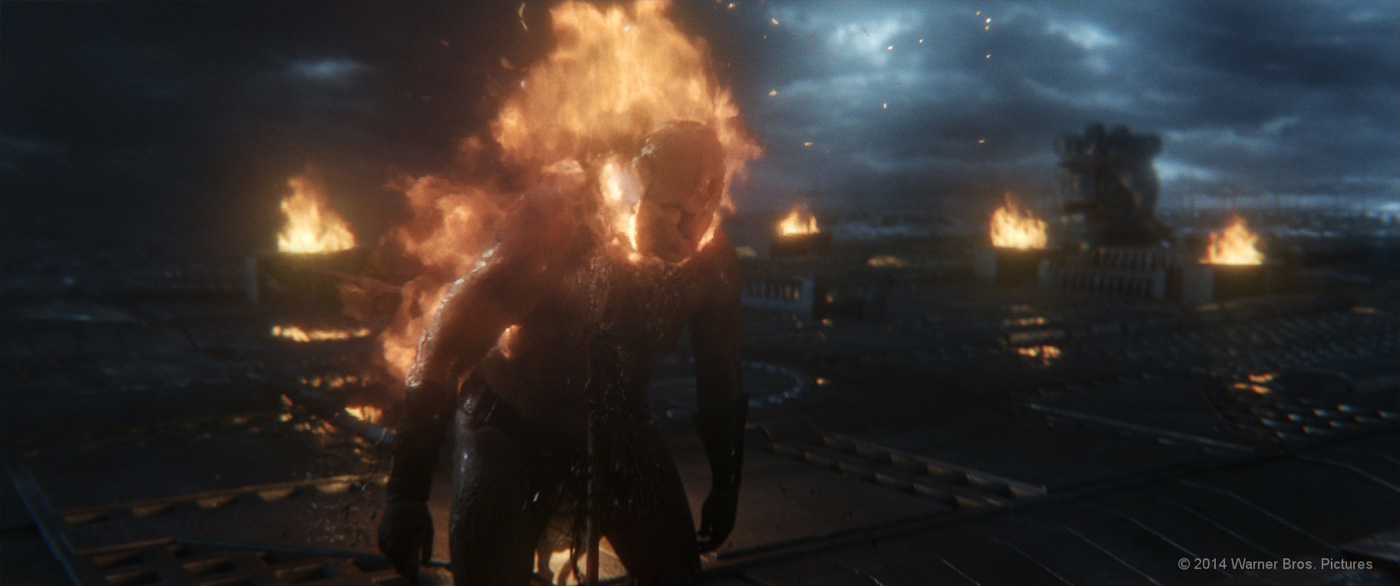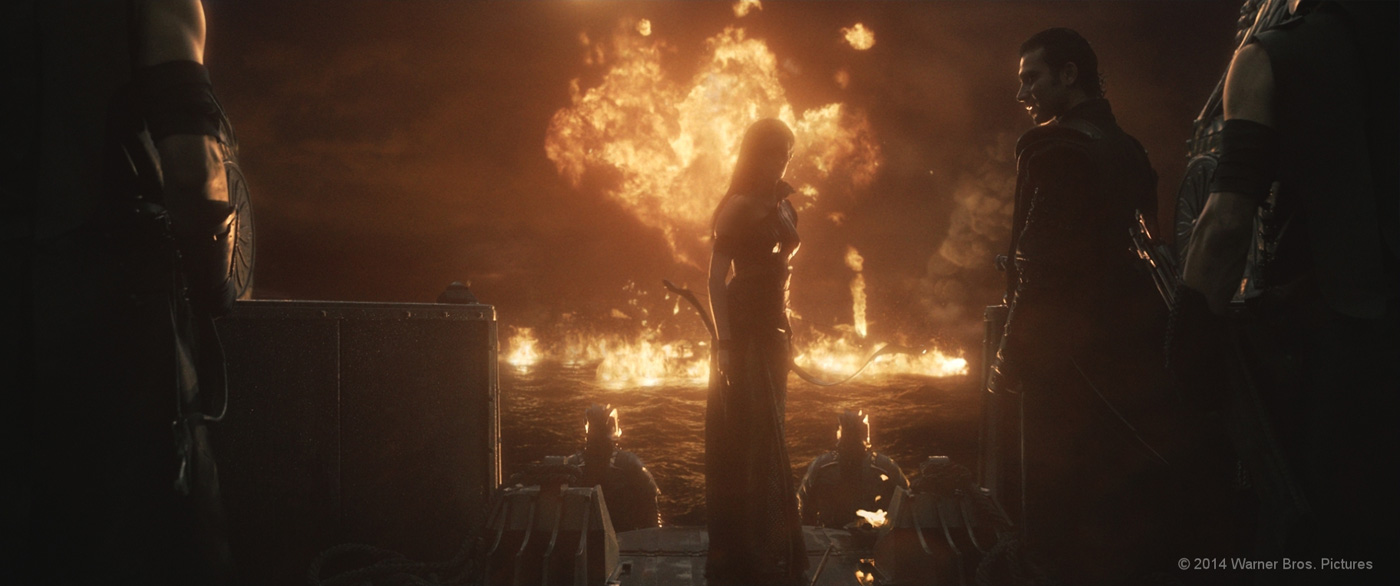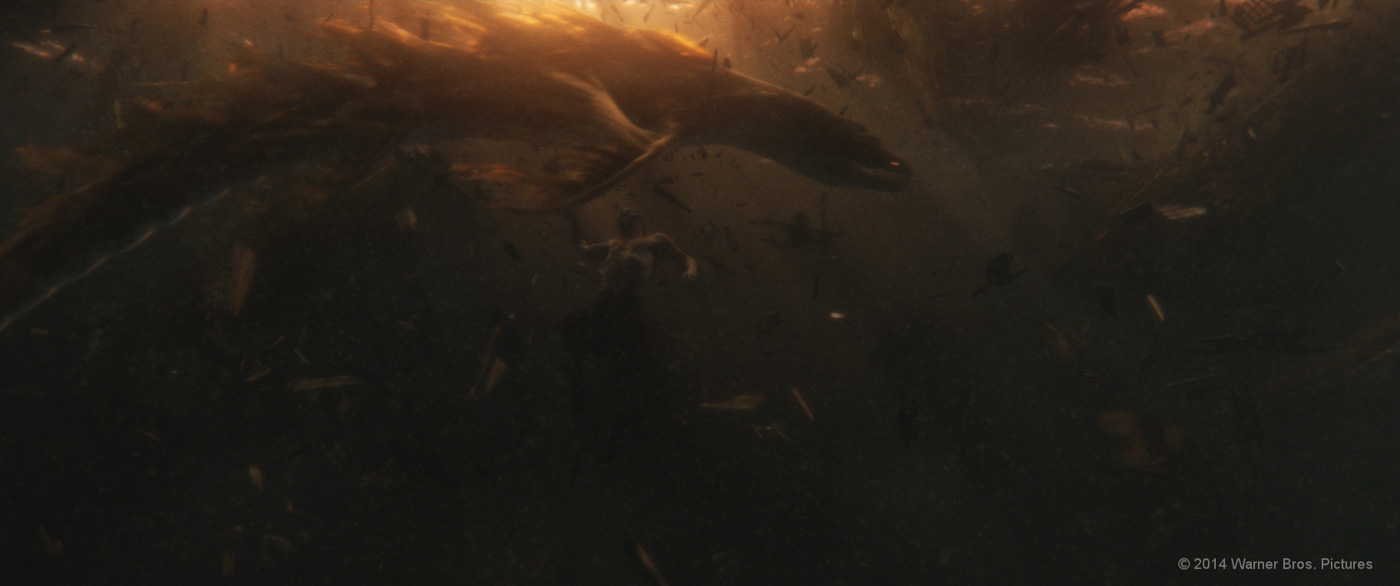In 2011, Danielle Plantec had detailed to us the work of Scanline VFX on IMMORTALS. She then worked on films such as IRON MAN 3, MAN OF STEEL or THE WOLF OF WALL STREET. In 2012, Byan Hirota talked about his work on SNOW WHITE AND THE HUNTSMAN at Pixomondo. He has moved then to Scanline VFX. Today, they explain in detail their work on the sequel of 300.
How did Scanline VFX got involved on this show?
Danielle Plantec // Scanline had worked on the first 300 film 7 years ago, while we were still in Munich. We did the storm shots with the ships crashing at the cliffs of the hot gates and our shots were featured the following year in the Electronic Theater at Siggraph. Consequently, when it turned out that 300: RISE OF AN EMPIRE’s screen play happened more than 50% with boats, battles and storms on the ocean, Chris de Faria and Anne Kolbe from WB invited us to a brainstorming session in fall of 2011. Over the course the months before the shoot started in July 2012, WB and Scanline refined the approach not only on how to shoot all this water action dry for wet in front of green screen, but we also started to develop the look of the 4 different battles: Circle-, Fog-, Fire- and Final-Battle.
How did you work with Production VFX Supervisors Richard Hollander and John DJ Desjardin?
Bryan Hirota // I am fortunate enough to have known both Richard Hollander and DJ for over twenty years each. Richard actually hired me to work at his company (VIFX) for my first visual effects job at the end of 1992 and I worked for him for eight years. Our long shared history made working together during pre-production and during the shoot in Bulgaria quite comfortable.
I’ve worked with DJ on innumerable projects and so working with him during post-production on this film was (as it always is) nothing short of an extreme pleasure.
What have you done on this show?
We contributed quite a bit to this film, specifically:
- In the prologue of the film: Greeks pushing boat into the ocean, tidal wave of blood, Spartans talking to Queen Gorgo on her ship
- The scene on Artemesia’s ship where she beheads the Greek spy and tosses it overboard
- The first ocean battle – “The circle battle”
- The second ocean battle – “The fog battle”, including the lead-in to the battle where Artemesia tosses general Bandari overboard
- The scene where Themistokles is taken to Artemesia’s ship with the big moon
- The third ocean battle – “The fire battle”, including the post-battle section where Themistokles sinks into the depths and is attacked by the sea creature
- The fourth ocean battle – “The final battle” including the so called Horse Run.
As a part of doing the scenes above, we built the following assets to share with other vendors:
Spartan, Athenian and Arcadian Greek Trireme ships. The various ships of the Persian fleet including (but not limited to) – Artemesia’s, Kashani and Bandari’s warships.
Additionally:
Even though the film was shot digitally there was a desire to replicate the original film’s grain heavy look. We conducted various tests to hone in on a way of applying an exaggerated digital version of Kodak’s 5279 film grain to our digital frames which was then shared with other vendors to maintain a consistent look.
Can you describe one of your typical day on-set and then during the post?
Bryan Hirota // On set it’s hard to describe a typical day since there was such a wide variety of material and shots that we were trying to achieve on any given day. The main constant was trying to make sure the footage was captured in a way that would allow us to complete the shots in post as the filmmakers envisioned without compromise. This could be something as straightforward as making sure we got good green screen coverage all the way to helping plan what passes needed to be shot for a multi-pass shot that will require a cg hand over. We were very lucky to have an outstanding data wrangling team of Felix Pomeranz, Giles Harding and Alex Collings who really took the bull by the horns to ensure we had all the lens information, texture photography and witness camera data that could be desired.
How was the shooting of the battle sequences?
Bryan Hirota // The battle sequences presented us with logistical challenges when shooting due to some of our limiting factors. The size of the largest stage was just long enough that we could fit a single Greek Trireme in it; given that the Persian ships were nearly three times longer so we could only bring a partial Persian ship (the full ship to be completed digitally in post) onto to the stage and never both at the same time. This required us to carefully plan based on the PreViz what piece was most beneficial to have on hand for any given day. The ships were on gimbals to allow them to pitch and roll as if they were at sea. We also had at our disposal some green platforms that were also on gimbals that we could drive forward with a forklift for shots where we wanted to have the sailors on a moving ship (which would be added in digitally in post.)
What was your work methodology for this show?
Danielle Plantec // Each sequence had a very distinct look and mood. The stormy circle battle, the almost mirror like water surfaces of the fog battle, burning oil on water in the fire battle. The initial exploration of these looks was a lot of fun. There are only a few movies where you have the full freedom to come up with crazy ideas. After everyone settled on some basic logic for each battle, we chose milestone shots in which we defined the sequence looks early on.
Can you explain in details about the ocean creation?
Danielle Plantec // All of Scanline’s water is simulated and rendered with our proprietary Fluid simulation software “Flowline”. Very early on before previs even started, we developed a Flowline realtime previs Ocean Rig for Third Floor. This allowed Third Floor to work with actual ocean caches and wind speeds that exist in reality. One of the biggest problems in physical based effects is when directors fall in love with a previs that will never actually work once scale and physical reality need to be taken into consideration. For example if an artist would animate the wave shape too fast, then the spray from the wave crests would not be able to fall fast enough, creating huge unrealistic curtains of water in the air. The meshes that were created for the previs rig were 2d representations of simulations and physically based. Thus, no matter what happened in the shot we could take the previs file and simply “converted” the rig to full 3d crashing rolling waves that can interact with the boats, have foam and whitewater etc. Our setups allowed us also to transition seamlessly out of full 3d water simulations in the foreground to simpler 2d simulations in the background. For every shot simulation artists could use a level of LOD that was suitable based on the needs.
The movie took place almost only on the ocean. Have you develop a specific pipeline to faced so many simulations shots?
Danielle Plantec // Stephan Trojansky Co-owner and VFX supervisor is also the mastermind behind Flowline. It started as a weekend project for him over 10 years ago and evolved into the FX system it is now. When we worked on the first “300” almost 7 years ago, we worked on 7 shots. Now we had to deal with roughly 700 shots. While we are constantly developing features to improve realism of our simulations, a big part is our FX pipeline is centered around Flowline. Artists can trigger simulation and rendering of all simulation aspects with one single button outputting everything needed for comp. A single shot might consist out of 15 simulation steps like Ocean Solving, Basic 3d Fluid, Surface creation, 2d wakes, 2d flows, Spray, Foam, Bubbles, Mist, Oil, Fire, Explosions, Wind. And these simulations in itself are distributed among many render nodes on the farm, acting as a big simulation cluster, not much unlike how super computers work these days where single problems get distributed among thousands of processors. Along with roughly 40.000 cores, we used 2 Petabyte of disk storage just for simulations.
What references and indications did you received from production for the various naval fleets?
Bryan Hirota // The designs for the Greek Triremes were based upon the reconstruction of an actual ship from antiquity. The group that had built a real sea worthy historical Trireme provided production designer Patrick Tatopoulos with the blue prints and he took it from there and fleshed out the design for the film and created the variations for the Athenians, Spartans and Arcadians.
We had a full size version on set in Bulgaria that we lidar’d. The full size set did not contain an interior so we had to combine the lidar from the separate interior rowing galley set in our construction of our cg versions of the ships. We also made sure to photo document both the exterior and interior sets so our cg model would match.
For the Persian fleet Patrick had designed a number of the large Persian warships. As mentioned above due to their size only portions of them were physically made. We lidar’d and photographed those individual pieces and similar to the Greek ship the interior was part of a different set that needed to be combined with the exterior.
Can you tell us more about their creation and their destructions?
Danielle Plantec // The ships were built off of the blue prints from production, log for log as you would build a real ship so the FX team could ingest it and trigger breakage and splintering based on stress points.
The support structures and skeleton of the ship were stronger while the simple cosmetic planking would tear off easier. The FX crew was able to define areas and cluster them so they could determine the level of destruction in specific areas, all the way down splintering. We additionally had several levels of simulation on the set dressing and props as well as rope and sail cloth simulation and tearing, all interacting with one another and the fluid systems be it fire or fog or water.
How did you created the various characters?
Bryan Hirota // We shot reference photography and scanned all of the main sailors so we had the material necessary to create the characters digitally. We also scanned and shot reference photography for a wide variety of extra sailors for all of the relevant navies so we had a wide variety of digital cast members to populate our ships.
We conducted two separate motion capture sessions one in Bulgaria and a second one in California to capture libraries of motions specific to this film. One of the trademarks of this franchise is that the stylistic flourishes extend even into the hand to hand combat. We wanted to make sure that even when the fighting went digital that it properly reflected stunt coordinator/2nd unit director Damon Caro’s vision.
Danielle Plantec // We then built multiple levels of characters, from lower resolution massive crowd characters to Hero foreground characters like Thermistokles, the proto samurai, Sea Serpents and our beloved horse.
Obviously they varied in complexity as the proto samurai had armor with moving plates and complex rigging as well as cloth simulation for the hair and skirt, and even their earrings were dynamic.
The horse was built to match a real horse down to the skeleton and muscular system and dynamic fur and hair.
For the proto Samurai work we usually started with roto animation of on-set stunt guys in silly pajamas, but Zack and DJ wanted the flexibility to change things and ultimately, most characters became completely hand animated. Likewise we had some motion captured characters and many hand animated characters mixed together throughout the film.
The crowds were done in Massive. To handle the sheer volume of shots, the team wrote a suite of tools that enabled us to distribute cached performances for the ship crowd assets directly into a shot. Being able to automate this process afforded us far more time to concentrate on hero performance crowds which in many cases featured hand to hand combat logic, dynamic agents and procedural ship to ship combat with projectiles all within Massive Prime and Jet.
There is a beautiful environment with a big moon. Can you tell us more about it?
One of the fun aspects of a film like this is the freedom to approach a sequence such as the one where Themistokles visits Artemesia and create a fantastical environment that is dramatic. The world started off with the idea of having a night sky with the moon lighting up the sea… we trying to take that ordinary concept and view it through the prism of the world that Frank Miller and Zack Snyder had created with the first movie.
One interesting bit of trivia is that we did receive a note from Zack asking us to make sure we make the moon as four day past full (we had it originally set to full) because based on the timing established in the first film with Leonidas’ visit to the Oracle and the Carnea that adjustment would keep moon continuity with the original.
How did you created the fire and the huge explosions for the Fire Battle?
Danielle Plantec // Flowline does not just simulate water, but also fire, clouds, dirt, mud, dust, you name it. Because of that, we are able to handle different types of simulations simultaneously. So we can have an oil simulation hitting the water and creating spray and bubbles and then catch fire and trigger explosion simulation… we can even have the blast from the explosion cause ripples in the water. There’s no limit to the combinations of interaction we can put into it.
In the final battle, Themistokles is riding a horse in a continuous shot. Can you explain in details about its creation?
Bryan Hirota // Once there was a general consensus on the previz we brought the shot in-house and re-laid out the horse’s animation. We tried to keep the framing and timings that everyone liked but used motion capture of a horse to make sure that the strides, accelerations and gallops were realistic. From there we layered in specific action for Themistokles’ combat. Once everyone was happy with the animation we needed to figure out how to shoot it. At this point we involved a company out of London called the VFXco. They took the previs and worked out how to film the move in multiple passes with their motion control camera and horse buck. We help figure out where the very long take could be broken into passes and rehearsed the action with the actors.
We then took the various selected takes and combined them with an additional piece shot on a dolly track of Themistokles jumping on the horse. Needed to stitch all the various pieces together. Use a cg bridge where necessary. Build the world around him. Build the horse. Go into the fight at the end with the proto samurai which itself was created from performance captured stunt guys and multiple takes needed to be stitched together.
Danielle Plantec // This shot was nearly 4’000 frames with hundreds if not thousands of interacting elements, all subject to retimes. To accommodate, the retimes we had to plan and work everything out from animation to simulation in 96 frames. This meant we were handling close to 16,000 frames for this shot.
We started to replace each part of the previs
- Thermistokles with full digital cape… leg replacement
- Ships crashing together splintering
- full digital humans
- Full digital proto Samurai with simulated cloth and hair
- Digital oceans and splashes with major retimes
- Horse with muscular systems and fur and hair and blood
- Burning ship
- Flaming horse
- The horse going underwater
- Practical characters interacting with full digital ones
- Digital blood landing on the deck and accumulating… We even had them leave blood footprints as they stepped through blood.
Describing this shot properly would be far too long an answer
What was the biggest challenge on this project and how did you achieve it?
Bryan Hirota // Biggest challenge was since we are such big fans of the world that Frank Miller and Zack Snyder and extending that world was a big challenge and responsibility. I think it’s fair to say that most of us working on the project are big fans of the original and were enthusiastic about being given the opportunity to revisit and extend that world. The work we were doing needed to feel like an extension or an evolution of the original and differentiate itself from the innumerable 300-like films that have come out since 2007.
Danielle Plantec // Interpreting this question a bit more literally, i’d say without a doubt, the Horse run shot. Not only was it nearly 4’000 frames, but it had tons of retimes and innumerable elements of multiple type of characters and creatures and simulations ranging from rigid body and splintering and cloth tearing, to fire blood and water, all interacting with one another.
How did you split the work amongst the various Scanline VFX offices?
Danielle Plantec // Bryan was the client contact and did all the hard stuff on set and in Bulgaria while Stephan and I stayed all nice and safe with the teams back in LA and Vancouver. After the set work Bryan was in LA and I moved almost full time to Vancouver.
We primarily divided work based on sequences so that we each oversee different work rather than just adding another layer of hierarchy. Bryan and I work really well together, so it was a pretty fluid workflow for us. I worked at the Munich studio for almost 4 years, so it made a lot of sense for me to oversee the overflow work we sent there as well as Vancouver. Stephan oversaw all Flowline simulation.
What do you keep from this experience?
Bryan Hirota // This movie was cool.
Danielle Plantec // We worked on the first film and did just 7 shots, 7 years later, for RISE OF AN EMPIRE we did over 700 shots. I learned that the numbers 7 and 300 are very good luck for Scanline. But seriously… I’d say that this was the single most fun show I’ve worked on in 18 years. The client was incredibly supportive and gave us an amazing amount of freedom to really do what we do best. The material lends itself to just doing crazy cool stuff… Like a Mohawk of blood, or a horse on fire diving under the ocean to put itself out… It was simply awesome fun. We had a rocking team across all 3 countries.
How long have you worked on this film?
Bryan Hirota // I was on the project just a bit over 15 months.
How many shots have you done?
Bryan Hirota // We delivered just over 700 shots for this film.
What was the size of your team?
We had a crew size of 223 members spread across three offices: Vancouver, Los Angeles and Munich.
What is your next project?
Bryan Hirota // I’m currently working on Ron Howard’s next film IN THE HEART OF THE SEA.
Danielle Plantec // I’m working on a show I can’t mention just yet.
A big thanks for your time.
// WANT TO KNOW MORE?
– Scanline VFX: Official website of Scanline VFX.
© Vincent Frei – The Art of VFX – 2014










